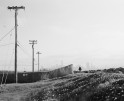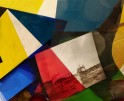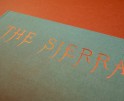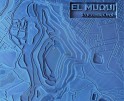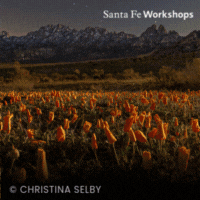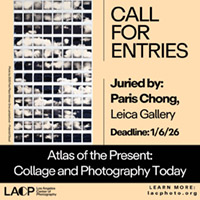Paul Graham: Verdigris / Ambergris
Whose is that light which makes the eye to see perfectly and the visible to appear?
You mean the sun, as you and all mankind say.
May not the relation of sight to this deity be described as follows?
How?
Neither sight nor the eye in which sight resides is the sun?
No.
Yet of all the organs of sense the eye is the most like the sun?
By far the most like. – Plato, The Republic
Paul Graham’s diptych titled Verdigris / Ambergris, published by MACK, is a meditation on the gaze, not of the viewer’s onto the photographs, per se, but of our human desire to understand by looking towards the horizon, by seeking through perception. There is a long tradition of horizon-watching from antiquity to the Romantic era of the Sublime (and its awe-inducing horror) and Caspar David Friedrich to Instagram and Snapchat. Made up of two books, one titled Verdigris and the other Ambergris, the works here undulate between the banal elegance we have come to expect from Graham and low-quality, glitchy, or fuzzy images that pull the viewer away from the gaze to enter a phenomenological space of contemplation.
The horizon, a perceptual phenomenon itself, is an illusion in that it is never truly lined or even an end. The word derives from ὅρος (hóros) which means boundary or landmark and from that ὁρίζω (horízō) ‘to divide, to separate.’ We see a division and thus treat it as such, but it is one of the mind, a human projection.
The photographs are made in a park overlooking post-industrial New Jersey, where Graham has worked for the past seven years. Nearly every photograph depicts a solitary individual, with a few pairs (a woman and a dog, two men, and so on). The figures are standing, sitting, or lying down, always still or at rest. The golden light or rosy tones of dusk bathe them in dreamlike scenes. There is humor here as well—one photograph depicts a squirrel looking out to the horizon in the same seated posture as many people throughout the book. This gives it a self-reflexive quality, poking fun at our folly as much as engaging in its seriousness. (I think here too of Bill Jacobson’s has a series that also does this in his series figure, ground).
The title, Verdigris, is the bright bluish-green patina formed on copper or brass by atmospheric oxidation, the natural condition we see most famously on the Statue of Liberty. Empire State Building. For Graham, this term comes to represent land.
Interleaved throughout these works are jittery images depicting close-up views of cherry blossoms. Graham captured these with a digital camera that employs multiple micro-shifted exposures (often known as “pixel shift”), resulting in high-resolution images. These images reveal their subtle movement—leading to a true expression of extrusive time. However, their kaleidoscopic appearance feels unnatural—the hyper color of a fever-pitch dream or hallucination coupled with the algorithmic artifacts due to digital assemblage or regeneration (the latter due to the struggles of the camera in assembling a coherent image from the plant’s movement).
Like Verdigris, the photographs in Ambergris depict people gazing out towards the horizon. Here, however, they look across the sea at the setting sun. People are in the water, lying, sitting, or standing in the sand, all looking intently at the sun. These works were made along the northern coast of Long Island, where there is a long tradition of watching the setting sun.
The title, Ambergris, stems from the solid waxy substance found in the intestines of the sperm whale, once highly valued in perfumery. For Graham, this is used to suggest the sea (Ambergris) and our desire to watch the “out there” as our earth turns away from the sun to give us night. These are more closely depicted in splotchy, out-of-focus, saturated, and noisy images depicting the sun just above the horizon or setting, which result from a camera that collects color information at every pixel site rather than the approximate color from nearby pixels. The images pushed to their limits, become stained with artifacts of the overwhelming intensity of information. Here, we may think of Penelope Umbrico’s Suns from Sunsets from Flickr series, and how much, as a species, we have reproduced this scene. It is a primordial draw, like we, like moths to a flame, crave it. For Hiroshi Sugimoto, the seascape connected him to his ancestors as the last unchanged view on earth, one that we may share identically (in a sense) with our past peoples and lives.
Unlike the twin book, there is a third group of photographs throughout these pages. They depict the interior space of an open window and are interlaced among the sunsets and the horizon-watchers. The whiteness of the window, sill, radiator, and semi-translucent curtain creates a stark division between that and the earthy greens, blues, and browns outside the window. The sunlight that passes through the curtain creates focused forms on the curtain—which billows from the breeze—that draw the viewer’s attention and cause the spaces inside and outside to recede. These photographs are perhaps the most important of the series as they attest to the liminality between internal and external, material and immaterial, which seems to be the conceptual linchpin of the books. I think here of the phenomena of the Rayon Vert, that flash of green light that occurs at the moment the sun dips behind the horizon. It seems that life—from birth to death—becomes that flash of light.
This pair of books (can we call them equivalents?) is a meditation on the human folly of, yet a necessary attempt at, understanding life. It is a wonderful diptych that explores the fleetingness of our experiences and our concretized sense of self and knowledge, particularly when embracing the trope of looking out onto the landscape. Obvious connections will be made to Romanticism, but I think this is a mistake. The glitchiness yet poetic quality of the images coupled with their content shows a self-awareness of the absurdity of life and the slipperiness of perception (and thus knowledge based on it) that I find relevant to the current state of the world—we are here but perhaps not fully present. Paul Graham’s Verdigris / Ambergris series does not portend to some overwhelming sublimity of nature or some empty gesture of aesthetics but, rather, it exudes an unaffected, sincere everydayness that is grounded yet fantastical, a dual series of the interiority (mental, emotional, philosophical, dream) of life lived in the physical spaces of the exterior world.
Verdigris / Ambergris
Paul Graham
Two hardback books housed in an embossed slipcase
Signed by the artist
22.1 x 28.5cm, 136 pages
ISBN 978-1-915743-43-5
April 2024
€95 £85 $95
Paul Graham (British, b.1956) is a British artist who works in Fine Art photography. His pieces typically show people and objects in realistic settings with surreal or unusual elements added to the image. Though Graham worked as a photographer during his 20s, he did not have his first show until he was 30. This show took place at the Watershed Gallery in Bristol, England, in 1986. That same year, he received the GLC Publications Award and the Arts Council Publications Award. Graham also received the Young Photographers Award, the Channel 4/Arts Council Video Bursary, the Charles Pratt Memorial Fellowship, and the Royal Photographic Society Award. In 2012, the Hasselblad Foundation awarded him the International Award in Photography, making him the only British winner of the award. Though Fine Art photography existed for a number of years, Graham was one of the first photographers to begin working in the field during the 1980s. His work entitled A1-The Great North Road focused on a stretch of the A1 road, using bright and saturated colors.
Graham is the author of 12 books and survey monographs that document different areas of the world. A Shimmer of Possibility is a 12-book series that shows images he took across the United States. Empty Heaven documents his tour of Japan. He also created the books SteidlMACK and Phaidon. His pieces often highlight cultural or historic moments in history. For instance, Beyond Caring focused on the plight of the unemployed. Troubled Land is another famous piece because Graham was one of the first photographers to document the troubles in Northern Ireland.
Over the years, the photographer has participated in gallery exhibitions around the world, including those held at the Kodak Gallery in Tokyo, Japan, the Anthony Reynolds Gallery in London, England, the Karyn Lovegrove Gallery in Los Angeles, CA, and the Galerie Claire Burrus in Paris, France. The Pace/MacGill Gallery in New York, NY, displayed his work The Present in 2012. The Tate Gallery in London, England, The Metropolitan Museum of Art in New York, and the Arts Council of Great Britain in London all have his work on permanent display. Graham currently divides his time between London England and New York City.
Colin Edgington is a visual artist and writer who explores notions of accumulation, memory, fiction, politics of labor, exploitation, and the environment. His visual work has been exhibited internationally—winning the Iowa Review Photography Prize in 2012 for his photographic novel—and his writings published widely.
He holds an MFA in Art Criticism and Writing from the School of Visual Arts, NYC (2016), an MFA in studio art from the Mason Gross School of Arts, Rutgers University (2010), and a BAFA in studio art from the University of New Mexico (2005).
Posts on Lenscratch may not be reproduced without the permission of the Lenscratch staff and the photographer.
Recommended
-
Andrew Waits : The Middle DistanceDecember 20th, 2025
-
Photography Educator: Juan OrrantiaDecember 19th, 2025
-
Aaron Rothman: The SierraDecember 18th, 2025
-
Eli Durst: The Children’s MelodyDecember 15th, 2025
-
Paccarik Orue: El MuquiDecember 9th, 2025











